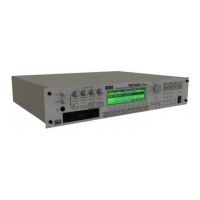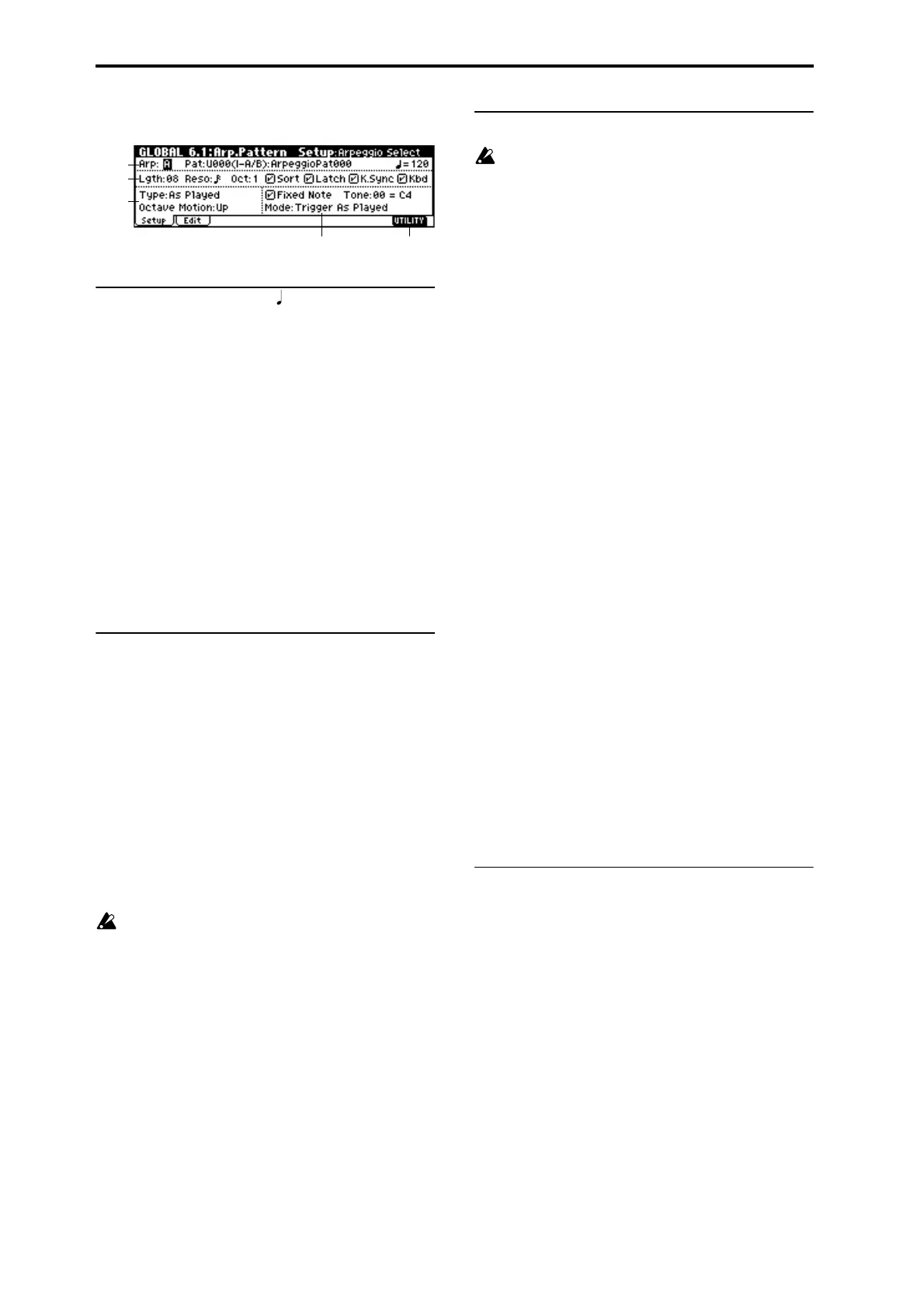120
6.1–1: Setup
6.1–1a: Arp, pat (Pattern),
Arp (Arpeggio Select) [A, B]
If you have moved from Combination mode or Multi mode
and edit an arpeggio pattern, you must select either arpeg-
giator A or B as the pattern to edit. Your editing will apply
only to the selected one.
B will not be displayed if you moved here from Program
mode.
Pat (Pattern) [P00...P04, U000(I–A/B)...U327(E–H)]
Selects the pattern that you wish to edit.
(Tempo) [040...240, EXT]
Specify the tempo.
This can also be adjusted by the REALTIME CONTROLS C-
mode [TEMPO] knobs. If “MIDI Clock” (2.1–1a) is External,
the display will indicate EXT and the arpeggiator will syn-
chronize to MIDI Clock messages from an external MIDI
device.
6.1–1b: Lgth, Reso, Oct, Sort, Latch, K.Sync, Kbd
Lgth (Length) [01...48]
Specify the length of the arpeggio pattern. After the note
value specified by “Reso” occurs for the number of times
specified here, the pattern will return to the beginning. This
parameter is not valid for preset patterns P00–04.
Reso (Resolution) [ , , , , , ]
Oct (Octave) [1, 2, 3, 4]
Sort [Off, On]
Latch [Off, On]
K.Sync (Key Sync.) [Off, On]
Kbd (Keyboard) [Off, On]
☞ PROG 6.1: Ed–Arp. “Setup(Arpeg. Setup)”
“Pat,” “ (Tempo),” “Oct,” “Reso,” “Sort,” “Latch,”
“K.Sync,” and “Kbd” are parameters that can be set in
Program, Combination, Multi, but you can also set
them here.
If you move here from Program or Combination mode
and set these parameters, you must return to the origi-
nal mode and write them. These parameters cannot be
written by the “Write Arpeggio Patterns” command in
this page.
6.1–1c: Arpeggio Pattern Setup
These parameters are not valid for preset patterns P00–
P04.
Type (Arpeggio Type) [As Played...Up&Down]
Specifies the correspondence between the arpeggio notes
specified from the keyboard of the connected MIDI instru-
ment and the Tone at each step.
As Played: If there are more Tones in a step than arpeggio
notes specified (notes played on the keyboard), those steps
will not sound.
As Played (Fill): If there are more Tones in a step than
arpeggio notes specified (notes played on the keyboard), the
last arpeggio note (the last-played note if “Sort” is Off, or
the highest note if “Sort” is On) will sound for those steps.
Running Up: If there are more Tones in a step than arpeggio
notes specified (notes played on the keyboard), the arpeggio
will return to the first note (the first-pressed note if “Sort” is
Off, or the lowest note is “Sort” is On) and sound it.
Up&Down: If there are more Tones in a step than arpeggio
notes specified (notes played on the keyboard), the arpeggio
will return in reverse direction from the last arpeggio note
back toward the first.
Example)
If you set “Lgth” to 04, “Step” 01 to Tone0, “Step” 02 to
Tone1,” “Step” 03 to Tone2, “Step” 04 to Tone3, and
simultaneously play three notes to produce an arpeggio,
the following results will be produced depending on the
“Type.”
As Played: 0 → 1 → 2 → rest → 0 → 1 → 2 → rest → 0 ...
As Played (Fill): 0 → 1 → 2 → 2 → 0 → 1 → 2 → 2 → 0 ...
Running Up: 0 → 1 → 2 → 0 → 0 → 1 → 2 → 0 → 0 ...
Up&Down: 0 → 1 → 2 → 1 → 0 → 1 → 2 → 1 → 0 ...
Octave Motion [Up, Down, Both, Parallel]
Specifies the operation when “Oct” is set to 2–4 octaves.
Up: Notes will repeatedly ascend within the specified range
of octaves.
Down: Notes will repeatedly descend within the specified
number of octaves.
Both: Notes will repeatedly ascend and descend within the
specified number of octaves.
Parallel: The notes of the specified octaves will sound simul-
taneously.
6.1–1d: Fixed Note, Mode, Tone No., Fixed Note No.
Fixed Note [Off, On]
Specifies the Tone type (the “●” or “❍” displays in 6.1–2) of
the arpeggio pattern.
Off (Unchecked): This is the normal arpeggiator type. The
Tone pitches will be expanded into an arpeggio based on the
note number played on the keyboard of the connected MIDI
instrument.
On (Checked): You can specify the note number for each
Tone. The note numbers from the keyboard of a connected
MIDI instrument will be ignored for the purposes of the
Tone pitch, and the arpeggio will be sounded using the note
numbers specified for each Tone. The note numbers from the
keyboard will only control the timing at which the arpeggia-
tor is triggered. This setting is suitable for arpeggio patterns
used for drum patterns etc.
6.1–1a
6.1–1b
6.1–1c
6.1–1e6.1–1d

